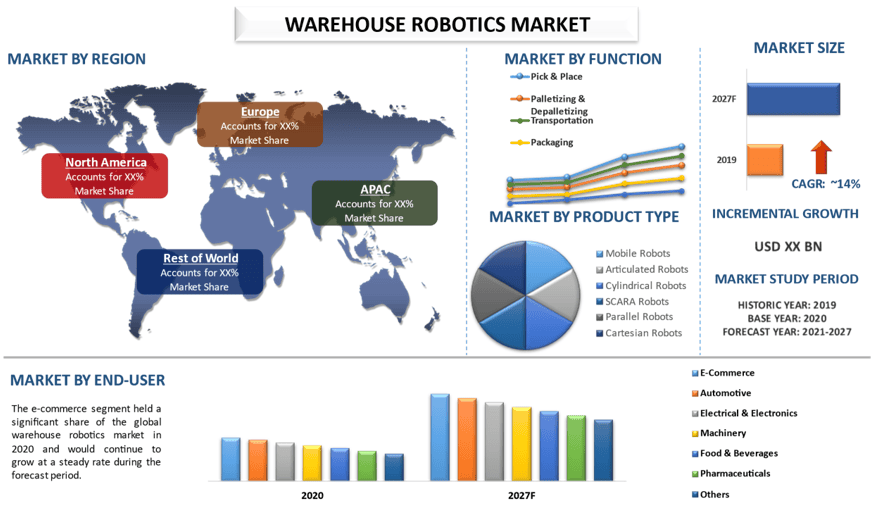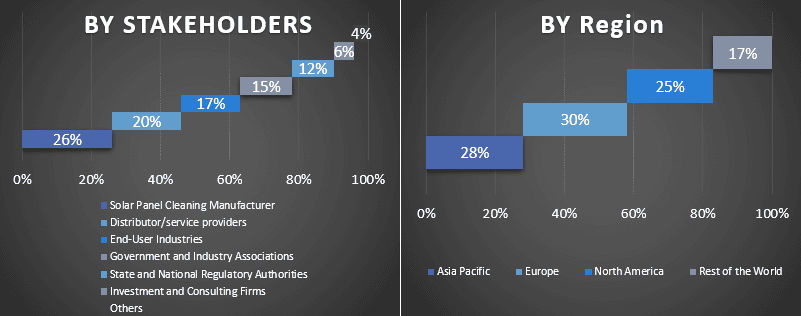- Home
- About Us
- Industry
- Services
- Reading
- Contact Us
Warehouse Robotics Market: Current Analysis and Forecast (2021-2027)
Emphasis on Product Type (Mobile Robots, Articulated Robots, Cylindrical Robots, SCARA Robots, Parallel Robots, and Cartesian Robots); Function (Pick & Place, Palletizing & Depalletizing, Transportation, Packaging, and Others); End-User (E-Commerce, Automotive, Electrical & Electronics, Machinery Food & Beverages, Pharmaceuticals, and Others); and Region/Country

The global warehouse robotics market is growing on account of the rapidly increasing warehouse automation along with the increasing collaboration of warehouse robotics with e-commerce. Moreover, the globally rising labor costs followed by the availability of scalable technological solutions are positively impacting the industry landscape. Warehouse automation offers benefits such as reduced labor costs, increased speed, higher efficiency, and accuracy. The main factor behind the growth of warehouse robots is the growing demand for automation due to intensifying competition in e-commerce. Success in e-commerce depends on who can deliver the right quality, at the right time, at the right place, and who can meet the expectations of customers Warehouse robots can help e-commerce companies to achieve their targets of faster delivery without compromising the quality of packaging. Since the e-commerce and manufacturing industry is growing at a prominent growth rate, the warehouse robotics market is also expected to grow at an influential growth rate.
KUKA AG, Yamaha Robotics Holdings, ABB Ltd, KION GROUP AG, Daifuku Co. Ltd., YASKAWA ELECTRIC CORPORATION, Fetch Robotics, Inc., Honeywell International Inc., Siemens AG, and FANUC Corporation are some of the key players in the market. Several M&As along with partnerships have been undertaken by these players to facilitate customers with hi-tech and innovative products/technologies.
Insights Presented in the Report
“Amongst product type, articulated robots category held a prominent share in the market in 2020”
On the basis of product type, the market is divided into mobile robots, articulated robots, cylindrical robots, SCARA robots, parallel robots, and cartesian robots. In 2020, articulated robots held a significant share of the market and are anticipated to witness influential growth during the forecast period. This is mainly due to the flexibility they provide during operation. It can perform arc welding, material processing, assembly, parts replacement, pick and place, packaging, system filling, and more. Articulated robots are widely used in manufacturing in a variety of applications such as welding, assembly, sealing, material handling, order picking, cutting, painting, and spraying.
“Amongst function, packaging category held a prominent share in the market in 2020”
On the basis of function, the market is categorized into pick & place, palletizing & depalletizing, transportation, packaging, and others. Among these, the packaging segment captured a significant share in the global warehouse robotics market in 2020 and is anticipated to hold a prominent share during the forecast period. This is because some companies are using robotic systems to improve packaging performance by installing sustainable and future-proof solutions. Packaging robots reduce labor and safety costs while increasing throughput. Robots operate at high speeds, increasing productivity and output. They allow the removal of loading funnels that slow down the throughput. Robots are also two qualities that are accurate, and flexible and contribute to their reputation as cost reducers.
“APAC to witness significant growth during the forecast period”
The Asia-Pacific warehouse robotics market is expected to witness a prominent CAGR during the forecast period. The growth of this market can be attributed to the growing industrialization, growing e-commerce industry, and rapidly rising manufacturing sector in the region. The economic growth in the region is resulting in increasing the trend of online retail shopping, the rising number of start-ups in the region that are developing robots, and the increasing prices of warehouse labor are further contributing to the warehouse robotics market. Moreover, several global companies are increasingly investing in the robotics companies in the region, which is further accentuating the warehouse robotics market. For instance, Indian robotics company GreyOrange raised $110 Mn in comprehensive growth financing. A majority of the latest funding came from its existing investor Mithril Capital Management and a specific group of current and new investors, along with separate financing provided by funds and accounts under management by BlackRock.
Reasons to buy this report:
- The study includes market sizing and forecasting analysis validated by authenticated key industry experts.
- The report presents a quick review of overall industry performance at one glance.
- The report covers an in-depth analysis of prominent industry peers with a primary focus on key business financials, product portfolio, expansion strategies, and recent developments.
- Detailed examination of drivers, restraints, key trends, and opportunities prevailing in the industry.
- The study comprehensively covers the market across different segments.
- Deep dive regional level analysis of the industry.
Customization Options:
Global warehouse robotics market can further be customized as per the requirement or any other market segment. Besides this, UMI understands that you may have your own business needs, hence feel free to connect with us to get a report that completely suits your requirements.
Table of Content
Research Methodology for the Warehouse Robotics Market Analysis (2021-2027)
Analyzing the historical market, estimation of the current market, and forecasting the future market of the global warehouse robotics market were the three major steps undertaken to create and analyze the adoption of warehouse robotics in major regions globally. Exhaustive secondary research was conducted to collect the historical market numbers and estimate the current market size. Secondly, to validate these insights, numerous findings and assumptions were taken into consideration. Moreover, exhaustive primary interviews were also conducted, with industry experts across the value chain of the global warehouse robotics market. Post assumption and validation of market numbers through primary interviews, we employed a top-down/bottom-up approach to forecasting the complete market size. Thereafter, market breakdown and data triangulation methods were adopted to estimate and analyze the market size of segments and sub-segments the industry pertains to. Detailed methodology is explained below:
Analysis of Historical Market Size
Step 1: In-Depth Study of Secondary Sources:
Detail secondary study was conducted to obtain the historical market size of the warehouse robotics market through company internal sources such as annual report & financial statements, performance presentations, press releases, etc., and external sources including journals, news & articles, government publications, competitor publications, sector reports, third-party database, and other credible publications.
Step 2: Market Segmentation:
After obtaining the historical market size of the warehouse robotics market, we conducted a detailed secondary analysis to gather historical market insights and share for different segments & sub-segments for major regions. Major segments included in the report as product type, function, and end-user. Further country-level analyses were conducted to evaluate the overall adoption of testing models in that region.
Step 3: Factor Analysis:
After acquiring the historical market size of different segments and sub-segments, we conducted a detailed factor analysis to estimate the current market size of the warehouse robotics market. Further, we conducted factor analysis using dependent and independent variables such as various product type, function, and end-user of warehouse robotics. A thorough analysis was conducted for demand and supply-side scenarios considering top partnerships, merger and acquisition, business expansion, and product launches in the warehouse robotics market sector across the globe.
Current Market Size Estimate & Forecast
Current Market Sizing: Based on actionable insights from the above 3 steps, we arrived at the current market size, key players in the global warehouse robotics market, and market shares of the segments. All the required percentage shares split, and market breakdowns were determined using the above-mentioned secondary approach and were verified through primary interviews.
Estimation & Forecasting: For market estimation and forecast, weights were assigned to different factors including drivers & trends, restraints, and opportunities available for the stakeholders. After analyzing these factors, relevant forecasting techniques i.e., top-down/bottom-up approach was applied to arrive at the market forecast about 2027 for different segments and sub-segments across the major markets globally. The research methodology adopted to estimate the market size encompasses:
- The industry’s market size, in terms of revenue (USD) and the adoption rate of warehouse robotics market across the major markets domestically
- All percentage shares, splits, and breakdowns of market segments and sub-segments
- Key players in the global warehouse robotics market in terms of solutions offered. Also, the growth strategies adopted by these players to compete in the fast-growing market
Market Size and Share Validation
Primary Research: In-depth interviews were conducted with the Key Opinion Leaders (KOLs) including Top Level Executives (CXO/VPs, Sales Head, Marketing Head, Operational Head, and Regional Head, Country Head, etc.) across major regions. Primary research findings were then summarized, and statistical analysis was performed to prove the stated hypothesis. Inputs from primary research were consolidated with secondary findings, hence turning information into actionable insights.
Split of Primary Participants in Different Regions

Market Engineering
Data triangulation technique was employed to complete the overall market estimation and to arrive at precise statistical numbers of each segment and sub-segment of the global warehouse robotics market. Data was split into several segments & sub-segments post studying various parameters and trends in the areas of product type, function, and end-user in the global warehouse robotics market.
The main objective of the Global Warehouse Robotics Market Study
The current & future market trends of the global warehouse robotics market were pinpointed in the study. Investors can gain strategic insights to base their discretion for investments from the qualitative and quantitative analysis performed in the study. Current and future market trends were determined the overall attractiveness of the market at a regional level, providing a platform for the industrial participant to exploit the untapped market to benefit as a first-mover advantage. Other quantitative goals of the studies include:
- Analyze the current and forecast market size of the warehouse robotics market in terms of Value (USD). Also, analyze the current and forecast market size of different segments and sub-segments
- Segments in the study include areas of product type, function, and end-user.
- Define and analysis of the regulatory framework for the warehouse robotics market industry.
- Analyze the value chain involved with the presence of various intermediaries, along with analyzing customer and competitor behaviors of the industry.
- Analyze the current and forecast market size of the warehouse robotics market for the major region.
- Major countries of regions studied in the report include Asia Pacific, Europe, North America, and Rest of the World.
- Company profiles of the warehouse robotics market and the growth strategies adopted by the market players to sustain in the fast-growing market
- Deep dive regional level analysis of the industry
Related Reports
Customers who bought this item also bought










